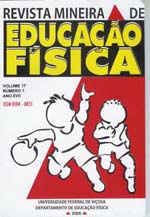BODY LANGUAGE AND EXPRESSION: THE COMMUNICATION MYSTERIES OF DEAF PEOPLE
Keywords:
hearing loss, motor activity, languageAbstract
The process of inclusion of people with disabilities in society has been seeking ways to integrate the individual in their environment. The use of artistic languages such as music, dance, painting, among others, has been shown to be important as a methodological strategy to be used in formation and inclusion of students with disabilities in school. This study aimed to analyze the relationship between body, movement and body expression in communication and deaf language, by the perception of educators. The study sample was composed of eight education professionals, of which four with degrees in Physical Education and three in Pedagogy. The methodological instrument used for data collection was the semi-structured interview, conducted face to face. The main issues addressed in the questions dealt on the body expression and the development of language and communication between deaf. The results identified the body expression as an important instrument of communication, language and inclusion of students with hearing disabilities in regular schools, in the view of educators.
Downloads
References
BISOL, C.; SPERB, T. M. Discursos sobre a surdez: deficiência diferença, singularidade e construção de sentido. Psicologia: teoria e pesquisa, v. 26, n. 1, p. 7-17, 2010.
DELGADO PINHEIRO, E. M. C.; OMOTE, S. Conhecimentos de professores sobre perda auditiva frente à inclusão. Revista CEFAC-Centro de Especialização em Fonoaudiologia Clínica, São Paulo, v. 12, p. 633-640, 2010.
GUARINELLO, A. C.; BERBERIAN, A. P.; EYNG, D. B.; FESTA, P. S. V.; MARQUES, J. M.; BORTOLOZZI, K. B. Libras discipline in speech language therapy academic context. Revista CEFAC – Speech, Language, Hearing Sciences and Education Journal, São Paulo, v. 15, n. 2, p. 334-340, 2013.
INSTITUTO BRASILEIRO DE GEOGRAFIA E ESTATÍSTICA. Primeiros dados definitivos censo 2010. Disponível em: <http://www.ibge.gov.br> Acesso em: 30 jul. 2013.
NOBREGA, J. D.; DE ANDRADE, A. B.; PONTES, R. J. S.; BOSI, M. L. M.; MACHADO, M. M. T. Identidade surda e intervenções em saúde na perspectiva de uma comunidade usuária de língua de sinais. Ciência & Saúde Coletiva, Rio de Janeiro, v. 17, n. 03, p. 671-679, 2012.
NOVAES, B. C. A. C.; VERSOLATTO-CAVANAUGH, M. C.; FIGUEIREDO, R. S. L.; MENDES, B. C. A. Determinants of communication skills development in children with hearing impairment. Jornal da Sociedade Brasileira de Fonoaudiologia, São Paulo, v. 24, n. 4, p. 327, 2012.
RIOS, N. V. F.; NOVAES, B. C. A. C. O processo de inclusão de crianças com deficiência auditiva na escola regular: vivências de professores. Revista Brasileira de Educação Especial, Marília, v. 15, n. 1, p. 81-98, 2009.
Downloads
Published
How to Cite
Issue
Section
License
Os artigos submetidos e publicados são de inteira responsabilidade de seus autores, não refletindo necessariamente a opinião do Comitê Editorial. A revista se reserva o direito de efetuar, nos originais, alterações de ordem normativa, ortográfica e gramatical, com vistas a manter o padrão culto da língua, respeitando, porém, o estilo dos autores. O manuscrito submetido deve ser original, não podendo ter sido publicado em qualquer outro veículo de informação científica, e nem submetido para publicação em outra revista científica. Os trabalhos publicados passam a ser propriedade da revista Mineira de Educação Física, ficando sua reimpressão total ou parcial de acordo com a licença Creative Commons Attibution 4.0. Deve ser consignada a fonte de publicação original. Os originais não serão devolvidos aos autores. As opiniões emitidas pelos autores dos artigos são de sua exclusiva responsabilidade.





 Esta obra está licenciada com uma Licença
Esta obra está licenciada com uma Licença 